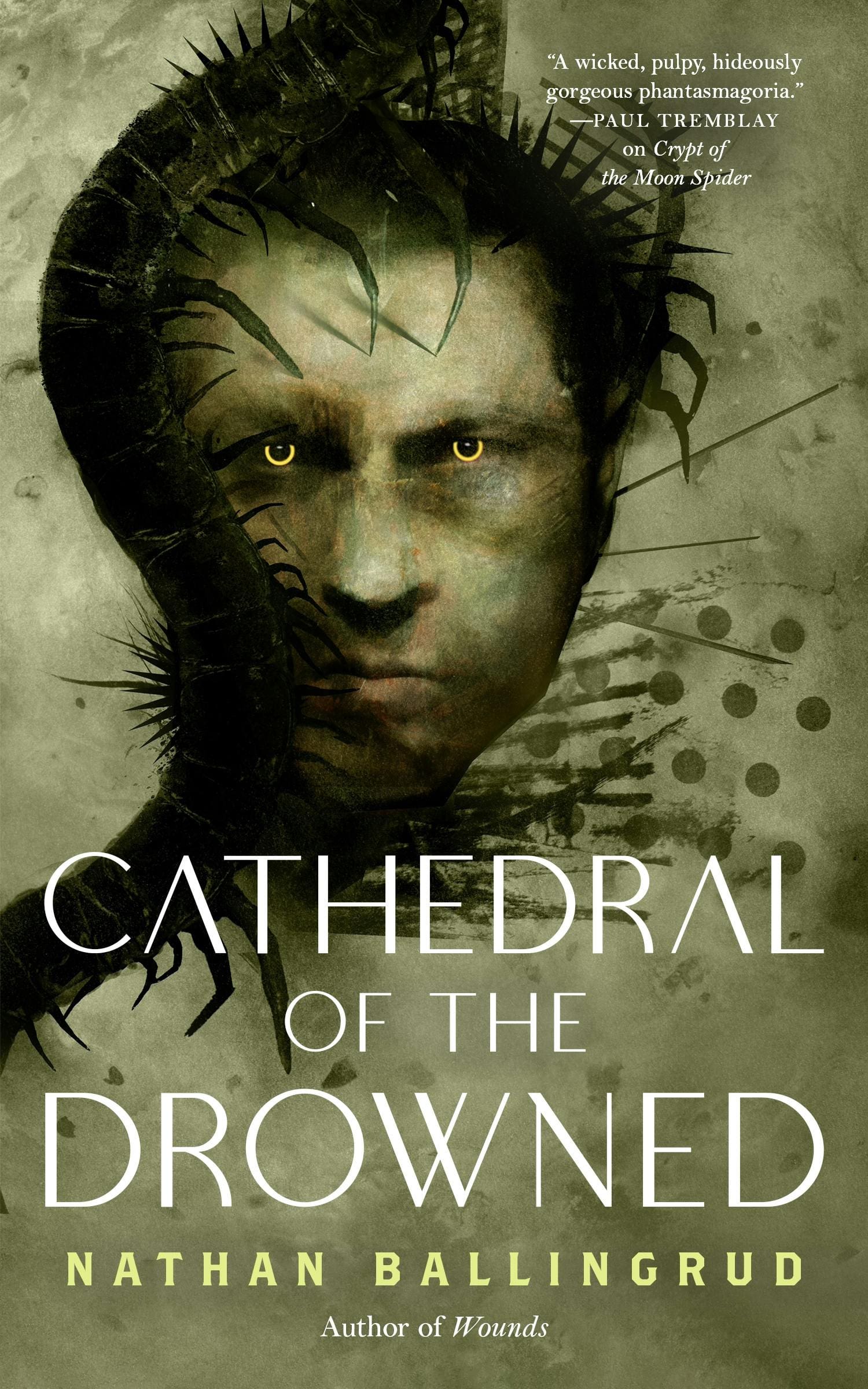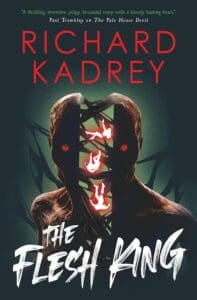
Synopsis:
The sequel to Crypt of the Moon Spider, Cathedral of the Drowned is a dripping, squirming, scuttling tale of altered bodies and minds.
There are two halves of Charlie Duchamp. One is a brain in a jar, stranded on Jupiter’s jungle moon, Io, who just wants to go home. The other is hanging on the wall of Barrowfield Home on Earth’s own moon, host to the eggs of the Moon Spider and filled with a murderous rage.
On Io, deep in the flooded remains of a crashed cathedral ship, lives a giant centipede called The Bishop, who has taken control of the drowned astronauts inside. Both Charlies converge here, stalking each other in the haunted ruins, while a new Moon Spider prepares to hatch.
Review:
Picking up immediately where Crypt of the Moon Spider left off, Cathedral of the Drowned follows Dr. Cull’s return to Red Hook where he joins up with local mobster Goodnight Maggie, seeking protection from the Moon Spider and her murderous cultists, the Alabaster Scholars. Maggie has problems of her own, as she begins to feel the squeeze of the Sicilian’s growing power, which has left two of her men dead. At night, she’s haunted by the ghost of Charlie, an enforcer she had sent to the moon to work for Cull, and who instead became a lab rat in the bad doctor’s various experiments revolving around the human brain and moonsilk. A section of Charlie’s brain has been removed and sent to Io, one of Jupiter’s many moons, where frightening discoveries await.
Oh yeah, all this is set in the 1920s, too.
If it sounds like there’s a lot going on, well… there is. Somehow Ballingrud makes it all digestible and easy to follow, keeping all of the very high weirdness remarkably grounded. Cathedral of the Drowned, however, is not a proper starting point for the uninitiated, with Crypt of the Moon Spider, the first entry in Ballingrud’s Lunar Gothic Trilogy, being a must-read prior to starting this one. Woe to the poor reader who picks up this book expecting a complete and self-contained story! The looks of confusion upon their faces are sure to be hilarious, though, as they try to figure out what they surely must have been drugged with prior to descending into this dream-occluded nightmare.
For those who might need some selling on The Lunar Gothic Trilogy, which upon Cathedral‘s release in October will be two-thirds completed, Ballingrud forgoes any modern scientific realism in favor of crafting a pulpy retrofuturistic horror story that owes far more to Edgar Rice Burroughs than Neil deGrasse Tyson. Where Burroughs had John Carter of Mars, Ballingrud has his Spider Woman of the Moon. The first book in his trilogy dove into the spider-webbed forests and Dr. Cull’s sanitarium on Earth’s moon. Here, Charlie’s dissected brain pilots a satellite to Io, the Jungle Moon of Jupiter, where a massive Cathedral ship from Earth has crashed and its crew of dead priests roam under the control of a titanic centipede god known as The Bishop.
All-in-all, it’s a throwback to classic pulp adventures from the early 1900s up through the black-and-white sci-fi flicks of the 50s. Ballingrud plays it all straight, too. He doesn’t try to explain anything away, like the hows and whys of regular, routine space travel for the common man and woman of the 1920s. It all just is. Readers are trusted to accept it without any fussy hand-holding. And unlike the retrofuturistic 1950s-inspired Fallout series of video games and TV show, there’s no tongue-in-cheek whimsy or self-referential silliness. Both this and the previous Crypt of the Moon Spider are hard-edged, cut-your-throat serious works of alt-history that pays terrific, and terrifying, homage to the stories and creators of yesteryear. While it shares some superficial similarities to Ballingrud’s other fantastical, alt-history sci-fier, The Strange, he also brings in plenty of horror, both body and cosmic, not to mention the plain old savage kinds, too. In some ways, these two Lunar Gothic stories feels like a marvelous blend of both The Strange and Wounds: Six Stories from the Border of Hell. Certain passages here can’t help but remind one of “The Atlas of Hell” or his diabolical surgeons from “The Maw.” Ballingrud’s revisionism of the 1920s feels both real and ethereal, as degrees of the familiar coexist alongside nightmarish otherness. The more one buys into this world, the more they’ll be greatly rewarded.
Cathedral of the Drowned is also very much the middle child of this trilogy. It’s the essential middle part in Ballingrud’s narrative and readers are expected to already be familiar with this crazy world and what’s come before. They’re also expected to understand that this entry is, by its very nature, an incomplete story. Cathedral is a fine entry on its own, and a great follow-up to Crypt, but it also exists within the context of an as-yet-unfinished three-book cycle and how good or worthwhile it is depends on how well the third book lands. While Cathedral ends with a bang, it’s not THE ending to this story. There’s another book coming in 2026, and Cathedral does the necessary work to position these characters and align the stars for whatever weirdness comes next. If the first two books are any indication, we can expect the grand finale to be absolutely bonkers.









Leave a Reply